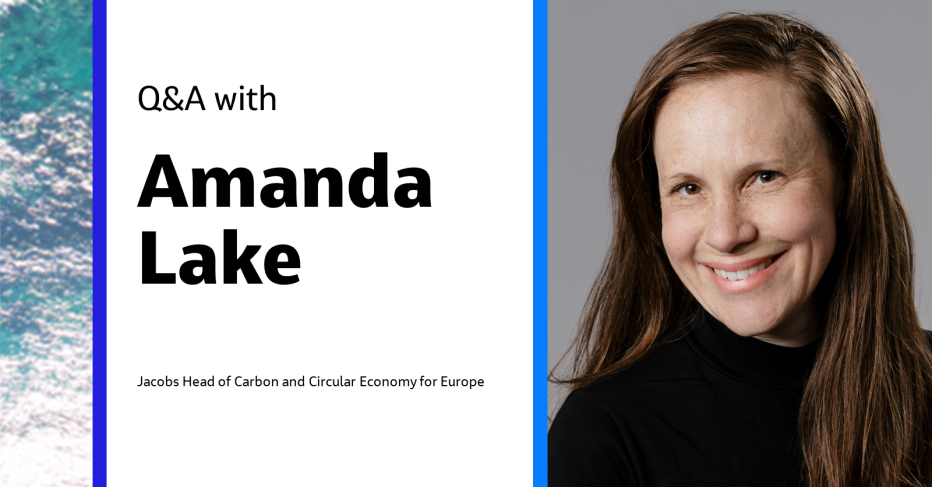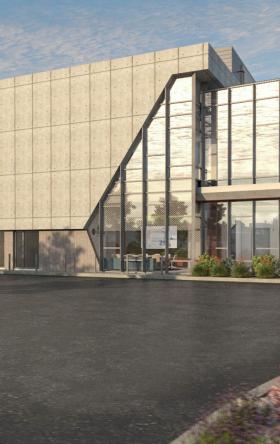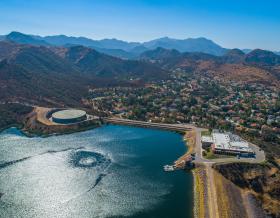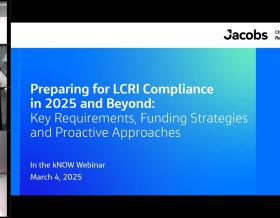
Water management is an energy and resource-intensive industry that produces high levels of scope one carbon emissions, and its effects are being compounded by climate change. Amanda Lake and her talented team of tech-savvy engineers and specialists are fundamentally pushing the sector forward in the critical space of process emissions, particularly nitrous oxide and methane. Amanda shares why a new economic framework, nature-based solutions and innovative technologies are vital in responding to this global carbon challenge in the water sector.
Hi Amanda – could you please describe your career to date?
I've had the pleasure of being with Jacobs since 2008, and before that, all my roles were in the water industry. I started working in Australia before moving to the U.K., where I worked initially for another consultancy in Bristol before moving up to Scotland with Jacobs. As an engineer, I’d always wanted to do something sustainability-related, so I chose the environmental option, an accredited process engineering degree.
For the past 22 years, my work has been process engineering in the water industry, specifically water and wastewater treatment using conventional and nature-based solutions. In the last few years, I've made an intentional effort to move into the related areas of climate action and circular economy — which are linked to all we do in water — but coming into focus as we tackle the climate, biodiversity and broader societal crises.
What does your current role involve?
My current role is the Head of Carbon and Circular Economy within water in our European business unit. I'm also a discipline lead for process engineers within the water business, but now we’re recruiting for that role so that I can focus more on strategic work.
Within that strategic work, I support a range of clients both in the U.K. and Ireland on carbon issues, but also globally within the areas of greenhouse gas solutions in wastewater treatment, and I also help unlock opportunities for circular economy practices in the way we’re managing the urban water cycle. I focus on preparing and collecting the right skill sets for our teams and clients, and I help share and implement global lessons.
Why are circular economy principles essential for the water sector?
We're proud to have done some of the formative work for the water sector here, and it has been used in Singapore International Water Week and elsewhere. Our global challenge is to evolve from linear economic models founded on the infinite supply of resources and growth. This is where it’s crucial to link materials with carbon use, as in a true circular economy we aim to keep materials in use.
That would help minimize our inputs and help regenerate the natural systems we're abusing. The global answer to climate change can’t rely on recycling alone — we need a whole new way of thinking, and circular economy principles offer guidance. Fundamentally, there's a disconnect between our pursuit of endless material use and GDP growth and the need to remain within the footprint of one planet. This has a massive environmental and social impact, especially with inequality.
To move away from business as usual, we need to harness circular economy principles and work with cross-sector teams to educate clients and offer a broader range of innovative, data-driven solutions prioritizing people and nature.
What are the most significant challenges the water industry faces today?
It is a multi-modal challenge with three key factors: an absence of accurate risk measurement, affordability and a lack of systemic, long-term thinking.
The recent work of IPCC scientists shows we’re underestimating climate impacts, and, as a result, we’re struggling to quantify the financial risks to our sector.
The knock-on effect is that getting the investment required to tackle the root causes is more difficult than just superficially addressing them. Our challenge as a company is to show how climate change affects water quality and availability. In a worsening climate crisis, we will have less or more of it when we don't want it — we need far more action today.
The challenge is linking those two as cause and effect, which brings us back to the risk evaluation challenge. On top of this, we face the challenge of affordability in the U.K. While our solutions will create many green, nature-based jobs and offer social value, the current regulatory frameworks make it difficult for water companies to implement these. As customers, we also don’t pay the true value of water, so we aren’t thinking about ‘sufficiency’ — what do we actually need, including thinking about the water footprint of what we use and buy.
So, how do we do more with less? There is an opportunity for us to do things differently — more upstream thinking, digital solutions and to focus on asset operation and optimization for our clients. We also need to think systemically to cover the medium and long term across the water cycle, not just the short term. Case in point: It’s easy to focus on the end-of-pipe solutions like building a new part of your treatment plant or a new treatment process. However, it's much more challenging to tackle nitrogen pollution by going upstream and engaging with citizens about regenerative agriculture and the food we eat, even though it solves multiple facets of the same problem of water quality and availability.
Intervening at the source is more effective, but it’s also often more complex. We struggle to think and act meaningfully outside traditional funding models and reporting boundaries, and both need to evolve. Jacobs has a crucial role in helping to educate and overcome that — it starts by understanding what’s going on upstream.
How are you helping to solve our client’s biggest challenges?
Fundamentally, there's a constant need to maintain our existing infrastructure in water and wastewater treatment. Creating future-proof infrastructure includes moving from gray to green solutions and including more nature-based solutions alongside conventional options for long-term co-benefits. For example, a treatment wetland might provide wider benefits, whether it's biodiversity, public amenity or green space.
Beyond transitioning these assets, we also need to go upstream to respond to one of the greatest challenges in our material footprint: reducing the amount of water we’re using and the waste we’re producing. This is where principles of the circular economy come in, like recovering and reusing nutrients or making energy from wastewater.
While the support to decarbonize is still growing along with the necessary funding mechanisms, I believe this water challenge poses some of humanity's most significant financial and social risks. By default, it's a critical risk for our clients, and we know our market underestimates those risks. Solving our clients’ challenges requires reducing our demand, future-proofing our assets and tackling climate mitigation and adaptation.
“Our challenge as a company is to show how climate change affects water quality and availability. In a worsening climate crisis, we will have less or more of it when we don't want it — we need far more action today.”
What role do process emissions play in climate change?
Process emissions — the scope one emissions emitted when we treat water — are our most significant source of emissions as a sector, and it's up to us to decarbonize them. These are produced by the microorganisms that do the wastewater treatment. Recent research shows that nitrous oxide and methane emissions are much higher than initially thought.
We intentionally produce methane in anaerobic digestion processes and can use it as an alternative to fossil fuels. That creates a renewable energy source — but only as long as we're not leaking it. As a short-lived greenhouse gas, it has a warming potential around 80 times more than carbon dioxide over its short life in the atmosphere!
Nitrous oxide is another focus. Nitrogen is in the protein we eat; we break it down and excrete excess, and it’s then a nutrient we need to remove to avoid nutrient pollution in the water cycle. Some of that nitrogen gets converted to nitrous oxide, roughly 300 times as potent as carbon dioxide as a greenhouse gas.
However, we can reduce methane and nitrous oxide emissions, and this topic has gained so much focus over the past few years in the global water sector. We must focus on recovering and re-using by-products like nitrogen, methane and phosphorus produced in the water cycle. Case in point: progressive work in Switzerland recovers ammonia from a wastewater treatment plant and turns it into fertilizer. That transforms a waste product from the water cycle into a product, avoiding the traditional fertilizer production process that uses a vast amount of fossil-based energy and reducing nitrous oxide emissions. The war in Ukraine and resulting gas prices have hugely impacted the fertilizer industry, as supply chain issues and the fuel price hike have forced factories to close. Now is the time to fix nitrogen and close our nutrient loops in water toward a true circular economy.
That’s a strong link between climate mitigation and circular economy principles which offer sustainability and resilience. It goes back to the example of thinking upstream to find solutions and going downstream to produce new products from our Water Resource Recovery Facilities (WRRFs), like fertilizers and recycled aggregates. We work upstream with industrial clients, and this — plus catchment solutions — is key to help prevent pollution at source. We have a deep catchment focus as they offer a vital focus of opportunities for the water cycle. If we get these nature-based solutions right upstream, everything downstream will be improved, including water treatment and use and downstream wastewater management.
This is where the concept of Planetary Boundaries is crucial. It’s a scientifically quantified framework of nine boundaries that shows the limits of our biosphere. The planetary boundaries include climate change, nutrient pollution, freshwater use and even novel entities like microplastics that are permanent sources of pollution. The latest updates show that we’re breaching six of the nine boundaries and creating conditions that are simply not conducive to life on Earth — which is incredibly worrying. The planetary boundaries are well aligned to the impact categories we use in lifecycle analysis, and they help us understand the impacts of solutions we’re co-creating with clients. The planetary boundaries framework and related tools like life cycle analysis offer valid solutions that support multi-criteria and multi-stakeholder decision-making and help visualize our clients’ challenges. It empowers us to deliver systemic solutions at a project, program, catchment and global level.
What role is technology playing in the race to net zero?
Technology is critical. A good example is the triple carbon reduction innovation project we're working on with Anglian Water. We're trialing producing green hydrogen from water through electrolysis. We will also use oxygen, a byproduct of hydrogen production, in a membrane aerated biofilm reactor (MABR), an innovative wastewater treatment technology that offers opportunities to intensify our water resource recovery facilities at lower energy cost and hopefully also provide opportunities to reduce nitrous oxide. We’re using the oxygen by-product of green hydrogen production to supply oxygen-enhanced air or even pure oxygen to the MABR to treat the wastewater. We will be crunching the numbers and assessing the life cycle analysis with our academic and industry partners to see whether this might offer three ways to reduce greenhouse gas emissions (hence the triple carbon reduction). It’s truly exciting stuff!
There are also promising technologies that will allow us to recover more from wastewater, like lower carbon fertilizers which can then substitute fossil-fuel-intensive products. We're also working on data-driven solutions within our Digital OneWater approach that will enable us to optimize existing assets through big data and machine learning as well as conventional modeling approaches. These intelligent systems will create insights that empower people to run assets better. We need a step change to address water quality, energy and climate action, and collaboration is critical — we’re privileged to work with fantastic partners.
However, we shouldn’t be solely tech-reliant. As engineers it’s appealing, but we must embrace the existing wealth of low-tech solutions: demand management, catchment restoration and nature-based solutions. These are systemic solutions embodied in our OneWater approach at Jacobs. These solutions are often more challenging but offer many more co-benefits and must be considered alongside the conventional options. The way forward requires a better balance of upstream interventions that include nature-based solutions and downstream technology solutions — this requires working across disciplines and teams, which is fundamental to what we do at Jacobs.
What would people be most surprised to find out about you?
I love surfing and anything on the water. Surfers are renowned for being laidback, chilled people, and that’s probably the last description my colleagues would use for me. Lately, I’ve had fewer opportunities to get out due to work and family duties, and I need to work on this. Getting into the water instantly changes your outlook on your day and leaves you feeling fantastic.
What do you most enjoy about being part of Jacobs?
This one’s easy — it’s the people. Jacobs has the best people and a truly inclusive culture. I’m passionate about diversity and inclusion, and it’s incredible — even just in the time I’ve been in the industry — to see such positive change and, particularly, so many inspiring female leaders at Jacobs. The opportunities are absolutely there for a fulfilling and rewarding global career across all the markets and geographies we work in. Everyone gets a chance to share their opinion, and our fantastic teams have never-ending potential.
About the interviewee

Amanda Lake is Jacobs' head of carbon and circular economy - Water Europe. Amanda has 22 years of experience delivering a wide breadth of technical projects focused on the urban water cycle in Europe and Australia, including water and wastewater treatment, water reuse, emerging contaminants, and resource efficiency and recovery. Amanda has spent the past ten years leading multidisciplinary engineering teams and process teams – delivering technical programs, strategic schemes, design projects and site process investigations.
You might be interested in...
Join #OurJacobs team
What drives you drives us as we work to build a better world – together. At Jacobs, every day is an opportunity to make the world better, more connected, more sustainable. We’re always looking for dynamic and engaged people to join our team. Bring your passion, your ingenuity and your vision.













































